Today's bake insired by dabrownman and hanseata. Don't know what else to call this one but a Chestnut Fig Stout Rye. My first time working with dark rye. First time working with many ingredients for bread actually - beer, fennel, corriander, molasses, chestnuts.
It all turned out thanks to dabrownman's coaching when times got a little hairy.
Soaker and add ins - barley, cracked wheat, sunflower seeds and chestnuts

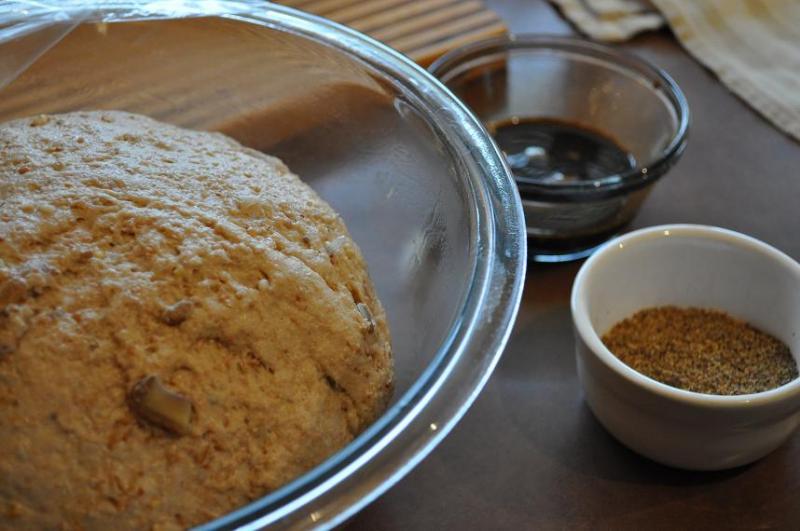
A local stout for a dark roasted flavour. And for a lazy winter Sunday warm up.
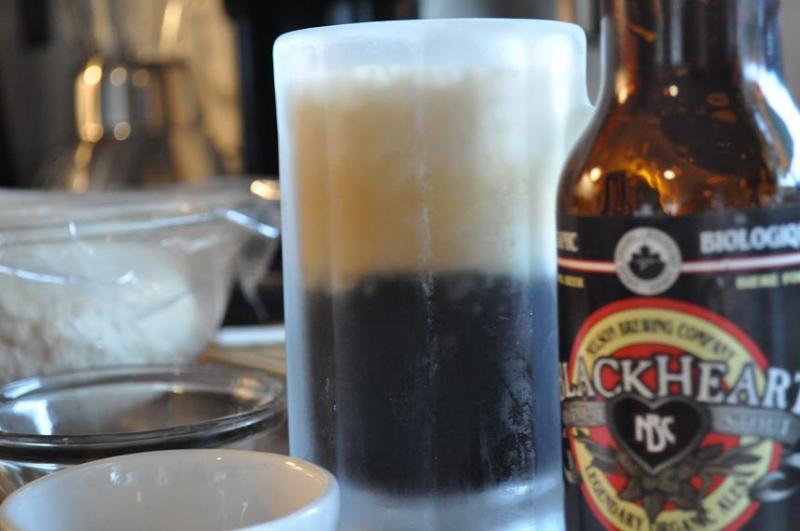
Can't wait for some badly needed brotforms.
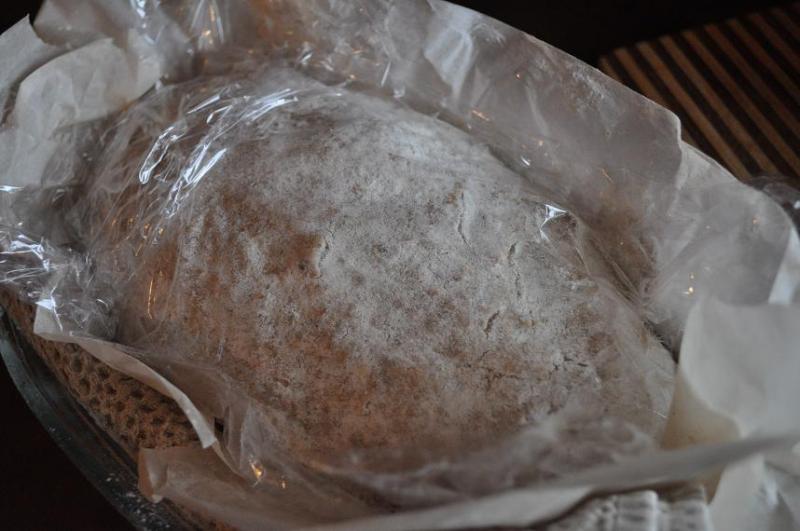
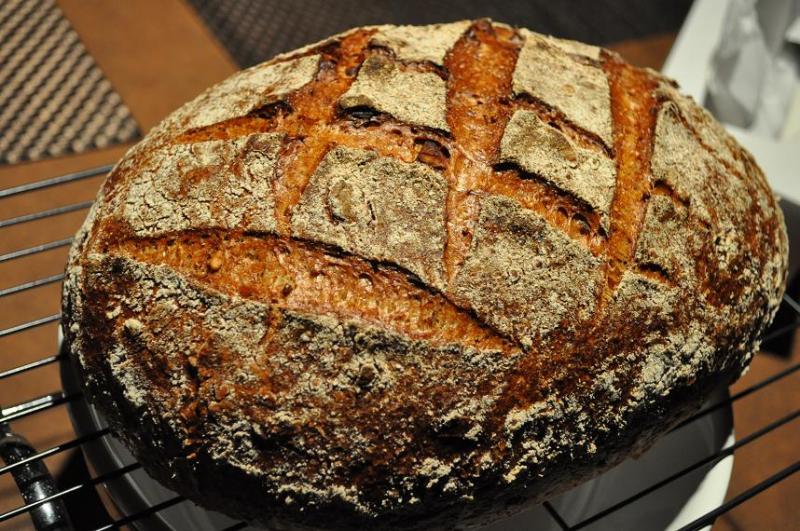


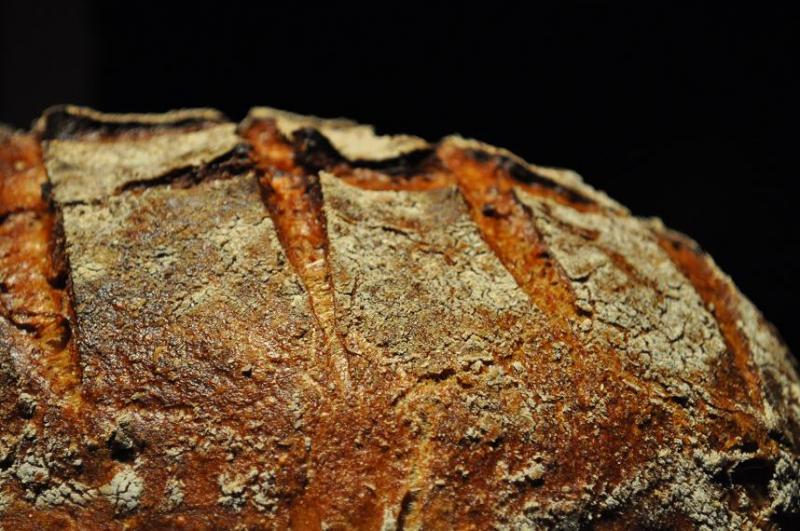

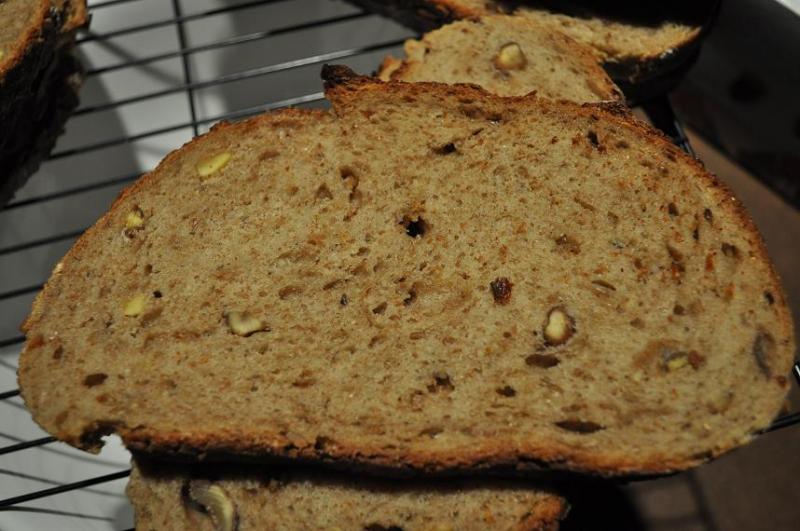
John,
What a beautiful loaf! I am impressed expecially since it contained so many 'firsts'. How did you like the taste?
The crust looks perfect and your scoring right on. The crumb looks wonderful with all to the 'goodies' dispersed evenly thoroughout. I can tell it has been heavily influence by Mr. D :-) You know he has a multitude of proofing baskets all picked up at his local Goodwill for mere pennies..
Thanks for the post and photos. Really nice loaf of bread!
Take Care,
Janet
Thank you Janet. It was quite the ordeal. I made a technical mistake in the dough build which made the dough way too dry at first and my 1980's Braun mixer died. Steel dough hook broke right off. May it R.I.P.
As for the flavour, it is good except the molasses taste came through a bit more than I would have liked. I think I will exclude that ingredient next time.
I hear rye gets much better a day or two after bake, so I am looking forward to the flavour developing.
John
and you have lots of pictures! Thank you for sharing!
I'm not big on molasses myself when it's over a teaspoon or two. Which turns out to be a level tablelspoon in my hands. What % rye did you settle in on?
Mini
Mini. Thank you for the compliments. Looks can be deceiving though! I am not good at baker percentages yet, but I used the following amounts of flour and water - I excluded all the add ins, seeds for simplicity:
Sourdough Build
Rye SD Mature Starter
90
Light Rye
110
WW
80
Water
70
Final Dough Build
WW
175
6 Grain Cereal
10
Dark Rye
20
AP
265
Bread Flour
490
Salt
12
Beer - 353 Water-67
420
VW Gluten
15
Honey
10
Balsamic Vinegar
5
Molasses
15
The other thing I noticed was this morning, hoping the bread would taste better due to it being rye and flavours developing, the crumb has an unpleasant mouth feel that I haven't experienced yet with bread. The best way to describe it, is pasty. I don't know why. The first few chews are ok but then after that the bread breaks down into a pasty, thick mass. I checked the temperature before removing from oven - 195 degrees. The overall flavour is good considering I didn't retard the proof overnight. The only complaints are the molasses (which did mute over night) and the pasty mouth feel.
Any thoughts?
John
the recovery was nothing less than amazing. A little calm thought on your part ,when things went wrong. really paid off in the end. I don't understand the pasty thing a day later though. Never had bread do that a day later and it is puzzling. Always something new!
I do think that I would have baked it to 200 F on the inside though and that great crust of yours would have just been uber fantastico! and the pasty part might have gone away? Or, if you like the way the crust came out, like I do, you can just cover the loaf with foil till it gets to 200 F on the inside. I'm not sure your 195 F would make that much difference though.
You only had 10% rye in this bread and a little over 20% WW so the pasty isn't likely coming from that. Maybe it will go away tomorrow.
The 46% hydration we know is pretty low and there was some extra liquid in the soaker or added along the way :-) I'm guessing it was really somewhere around 75% or so right?
Mini is correct, you have come a long way in a short time and your photos do turn bread into porn. Nice baking and sorry to hear about your poor mixer. It'so matter or worries either. Humans made bread for thousands of years without them and I have to admit I no longer use mine for bread very much at all. Got hooked on French slap and folds and S& F's instead.
Bake On John!
Thanks dabrownman. Did your loaf give off any molasses flavour? Mine did mute down after a day but I also used half of what you used.
Another mistake I made was possibly not dividing it into two batards or one long baguette/batard like yours. It took a long time to bake and the slices are rediculously large! Sandwhiches for a giant.
I will perfect it someday. I won't give up on this amazing bread :)
John
molasses flavor in the bread. It put a little hin of of sweetness in it. I mainly used it to color the crumb.
By not dividing it up the baking time would be much greater - but it sure was dramatic. You have about 30% whole grains in your version and i would normally bake that to 200-205 F. If it was 30% rye like, Eric's favorite rye, he baked that to 190 F - so I do too because he did.
No reason to give up on your nice bread that just needs a little minor tweaking to make it the way you want it.
Happy Holidays
Hey dabrownman. The recipe you posted calls for 10 grams of salt. Is this right? I used 12 grams and it still turned out quite bland. Of course, doesn't help that I am a salt fiend.
If you reply and I don't answer, I'm just out back using the salt lick.
John
formula calls for 10 g of salt which is based on 2% of the dough flour which in my case was 480 g. If you look a the entire amount of flour in the starter, levain and dough flour you get to 717 g total (VWG is a flour) 2% of that would be a little more than 14 g of salt. But I didn't put 14 g of salt in the bread for 2 reasons.
A recent study showed that Americans were consuming more than 3 times the salt than they should for a healthy diet. The study also showed that 70% of the salt consumed came from bread alone that had 2% the weight of flour in salt. I did some testing and found that at 1.5% salt of total flour I could not tell the difference in the taste of the bread. So by cutting back the salt to 1.5% it magically became 25% better salt wise for you. It is still too much salt for you from a health point of view but 2% salt is overkill and not necessary from my view. But, others can put as much salt in their bread as they want or feel necessary and I couldn't care less.
The 2nd reason for less salt in my case; I used wild rice that I had as a left over from dinner. The equivalent amount of rice I used; approximately 1/8 c dry (or 23 g dry) originally was cooked with an equivalent 2 g of salt. So my total 12 g of salt for 717 g of total flour is 1.67% salt - slightly more than I want but close enough.
In your case, you have an equivalent of 1210 g of total flour and I would use 18 g of salt if I made your recipe. Others would put 2% or 24 g of salt in your bread. I don't want the extra salt that I feel is not needed and prefer my bread to be healthier from a salt point of view - not to mention whole grains with natural leavening too.
As a note. The reason I use 2% of the dough flour for calculating salt in my formulas is that I usually use about 25% of the total flour in the SD or YW or combo levain build. My formula works out to 1.5% salt for total flour weight.
Hope this helps.
Totally makes sense. I had a feeling it was just a personal adjusment of salt made on your part. I completely agree with the studies and excess use of sodium in North America. Unfortunately for me, I love salt and tend to over season my food. I use less saturated fats, but still can't give up my salt. So far at age 37, I have perfect blood pressure, but cholesterol levels needed help a few years back. I got that in check with using more olive oil and cutting out shoving tons of pork meats in my maw.
John
Rye is lower than wheat, and you do have a good amount of wheat flour in the dough. Fudge! You will have to cut up the bread and toast it in the oven to finish the baking. The closer you slice to the middle, the worst the pastiness will get. You could try nuking slices of bread to finish baking, in fact that might be the way to go. The moisture will draw the heat. Such a pretty loaf too! You might end up cutting the loaf lengthwise down the middle and removing the unbaked part. Compact the dough into duplings if it still smells nice and drop into hot boiling soup until done. Were the chestnuts roasted or raw when they went into the dough? I tend to toast all my nuts and seeds that get folded into the dough. They can stay raw if on the outside.
I tend to bake rye to 205° F Wheat to 210°F Lower if fat and sugar are involved but this loaf looks pretty lean.
Mini. I will test to see if the smaller slices have the pastyness as well. The chestnuts and all the seeds were toasted/roasted first. I as well don't use raw seeds/nuts on the inside of the bread. If sprinkled on outside, I leave them un toasted so they dont get over done/burnt.
I have to say, this loaf was HUGE. It was the largest thus far that I have baked. It took a good 65 minutes till it finally read 195 degrees in middle.
Thanks for your suggestions as always :)
John
in my guesstimate. Roughly a 2kg loaf. leaps and bounds! :)
An hour and half?? Wow. So is the temperature read of 195 degrees internal temp. wrong for this type of bread?
Another thing I noticed was that the taste is a bit bland. Could I have added more salt without it effecting the yeast? I used 12g.
John
Sorry Mini I just realized your answered that question by suggesting 205 - 210 degrees for rye. Thanks.
John
that needs baking higher. Pure rye is actually 93°C (200°F) minimum internal temp and baking Wheat 96°C (205°F) minimum. Even if you call the loaf a "rye loaf" (technically a wheat loaf) aim for the higher wheat temperature due to the amount of wheat in the recipe. That way the loaf is thoroughly baked.
One of the things I learned at KAF was bread reached its optimum internal temp about 65% of the way through baking. So at 65 min you probaly had another 30 min left in the bake. Since it was such a large loaf you would have needed to lower the oven temp to prevent the crust from being done before the crumb. If dabrownman made baguettes or smaller batards he could get away with higher oven temps. So, I agree with mini your loaf was probaly underbaked in the middle.
It's a great looking loaf John,
But salt in the formula translates to around 1% on flour[plus grain]; somewhat low, methinks.
I work metric; core temperature should be 96*C after baking. 1.5 hours in the oven seems good to me
Best wishes
Andy
Thank you Andy. I will be making those adjustments in my next attempt at this or any other rye. The original recipe I riffed off of actually called for only 10 grams of salt. I upped it 2 grams but it still wasn't enough. I appreciate the help as always.
John
Hi John,
1% salt is low, 1,8-2,2 % is o.k.
Mirko
There are 2 tricks than can be done on most calculators
first method: multiply the flour weight by 0.02 for 2%
or second method: if you have a % button: 1210 + 2 %
Thanks for the tool Mini. I will be sure to use it in the future. Can you tell me how you got to 1210 grams of flour in my ingredients above? I can't seem to add up to that amount. Do you normally include mature starter weights and vital wheat gluten to final flour amounts?
John
assuming 45g of each water and flour in the 90g of starter (100% hydration starter)(?)
and yes, the 15g of vital wheat gluten.... total 1210g
45 + 110 + 80 + 175 + 10 + 20 + 265 + 490 + 15
Hydration: 45 + 70 + 420 + 5 =540g 540g ÷ 1210 = 44.6 or 45%
Hydration is low at 45% so there is more liquid coming not included in the post, most likely with the soakers. :)
But, I guess nthe extra water came into the mix after the mixer hook was destroyed by a stiff dough and not the in the soaker :-)
The only water I used was as follows:
Soaker: - 30 g water
Starter: - 70 g water
Final Dough Build: Beer - 353 g Water-67 g
John
(if I add 25g water to the starter fluids) the honey and molasses contribute just a tiny bit but perhaps have a deflocculating effect. Sourdough gets more liquid with fermentation. So what gives? Must have started out stiff and then with time got softer. Did you happen to record your actual total dough weight?
John, did you mix with wet hands? or Did you throw in an egg along the way?
This is like a baker version of hide-and-seek. :)
The mature rye starter is pretty runny at 350% hydration? 70 ÷ 20 = 3.5 (x 100 = 350%)
Me wonders if the low salt enabled the low hydration level in the dough by speeding up fermentation. More salt would have firmed up the dough a little bit and slowed down the ferment. Something to think about if doubling the salt amount. Next time, John, you may notice slight differences in dough handling & fermenting times.
I know what it was!!! Beer foam! There was a hearty head on that beer that didn't get weighed! :)
Mini. To be honest, I am actually quite happy the bread turned out the way it did and not worse! Considering my irresponsible techniques. I didn't write any changes down, nor did I pay a lot of attention to how much more water I was adding into the dough when I noticed it was too dry. I was so flustered and worried that I was just focusing on making it less solid dry.
Next time I make this bread I will make the necessary changes we spoke about and make sure I write it all down. I will also divide the dough into two loaves as the slices are rediculously large. Plus the bake time will be a bit less than the hour and half we spoke about. I am determined to make this one perfect. Or close to :)
Actually, toasted, the bread is quite nice. It must have definitely been the short baking time that cuased most of the issues.
John
That's an easy problem to overcome. Two kilo loaves are quite common in Austria, and your loaf is just so beautiful! Round loaves get cut in half and each half-loaf sliced as needed. Oval loaves make big sandwiches, true! A great loaf to work on your cutting skills. :) I often find a big slice very convenient to slice in half quickly having both sides to my sandwich. A big slice looks very impressive after spreading on all the goodies and presented "open faced" cutting into smaller pieces to pick up and eat. Eye candy.
This loaf is definately a keeper and deserves another round. Just the other day I had a desaster and didn't write down a single adaptation. I turned half a bad loaf into a cake and after assuring myself I wouldn't poison anyone, sent the cake to "the office." Now I'm being asked to repeat it and I have another half loaf to "recycle." It will not be the same for sure but I already know how to roughly improve it.
If you do make the same sized loaf, cover with foil and turn down the heat a little to finish the bake. I have often covered loaves to keep them from over browning. If you're worried about the bottoms, preheat the stone 25°F lower or move the loaf off the stone and onto a rack just above the stone to finish the bake. Rotating the loaf half way thru the bake is important with big loaves and a great way to check on the crust color. I have to open my oven door to see a loaf baking, the pretty glass is useless because it is both dark and mirrored. Even with the light on, I can't see or read my oven thermometer. I set the dial for 250°C to get 180°C. In a standard home oven, opening the oven door tends to add 5 minutes to the bake.
It is often the case that the first time I use a recipe, the oven gets tweaked for the second bake while the recipe stays the same. You have lots of info for doing both tweaking the oven and increasing the dough hydration. The added moisture should not be too difficult to figure out. Looking at your loaf, I would start with 65% hydration. (1210g x .65) [787g - (540g + 25g) = 222g ] Add 222g more water to total 787g. Don't include the honey or molasses in the calculation. When ready to mix, measure out an extra 100g water to use sparingly while mixing as needed. When your dough is together it is easy to see how much water is left from the 100g. Write down what you used. If you happen to use all 100g water, I figure the dough will have 73% hydration. (887g ÷ 1210g ) x 100 = 73%
Mini
Mini. True, I just cut the monster slices in half to fit in the toaster. To avoid over baking the crust, would you suggest a longer steam bake time? I only steam baked covered for 15 minutes and then the rest without. If I try the next bake at approx. 75 minutes, should I maybe steam bake covered for let's say, 30 minutes? Or is this not good for rye breads?
John
Don't change too many variables at once or you will not know what you did that changed should the loaf come out very different than what you expected. You are very close to having a perfect bake and doing well at it. Steep learning curves are great but come with patience. 15 minutes is plenty. You're doing just fine! Had the rug mixer pulled out from under you, sorry about that, but heck, you're still doing fine.
Mini
Nice baking John. I'm sure next time you will get it just the way you want it. Either way your loaves look beautiful and when you get the salt down right I'm sure they will taste even better.
Ian
Thanks Ian. It's funny, a day after I baked this loaf I got so discouraged I wanted to throw out this recipe and never try it again. 4 days later, as the rye developed some flavour and it dried out a bit, I am wanting to bake it again for sure. Especially with all the help everyone has given me to overcome some of the issues I had. It makes me even more determined to perfect it. I have learned a valuable lesson here. DO NOT GIVE UP SO EASILY.
I need to learn from the mistakes. It was my persistence with the Tartine Country bread that got me to finally be happy with my results. In fact, the same goes for Hamelman's 5 Grain Levain. I had at least 3 flubs until I reached success.
To all you new bakers out there, this is a good lesson to learn. Stay in school and stay off drugs...no wait, that's another speech.
John
We've all been there....sometimes it is not worth trying again, but in this case I think you were so close I'm sure your next bake will be perfect or close to it. I don't type all of my recipes up in baker's percentages but I usually calculate the hydration to check and see if I'm where I want to be for a certain type of bread. I usually use about the same overall amount of flour and other assorted add ins so my salt is usually fine, but with a new recipe it helps to calculate and make sure you are close to 2% and no less than 1.5% or your bread will be pretty bland for sure.
Good luck and keep baking...worse case scenario the squirrels will have some good food for the winter :).
Ian. Learning baker percentages is my next goal. I know it is quite simple, but it is a technique I have totally ignored and been ignorant to. Time to shape up and get workin!
John